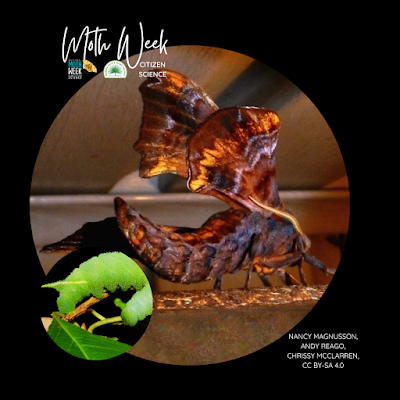National Moth Week 2023 - The Small-Eyed Sphinx Moth
The small-eyed sphinx is a large moth with vivid blue eyespots on its yellow and black hindwings. Scientifically known as Paonias myops, it belongs to the Sphingidae (hawk moth) family. It has a broad distribution in North America ranging from southern Canada to almost the west coast. However, the population of this species is best represented in the eastern portion due to its affinity for woodlands. They are widely distributed east of the Cascades in riparian habitats along creeks and rivers at lower elevations, and in mixed hardwood forests at higher elevations.
Adults are on wing from June to September in northern states where there are bivoltine (2 generations in a year). In Florida, they are polyvoltine (up to 4) due to warmer conditions. Paonias myops belongs to the Smerinthinae subfamily that is distinguished by their unusual resting position- where the hind wings remain visible while stationed under their forewings. The main body of the moth also has a pleasing curvature- as demonstrated in the photograph.
Females can average 45 millimeters to 75 millimeters (up to 3 inches) while males are usually smaller. The eyespots on its wings are smaller in comparison to other sphinx moths. These small black and blue eyespots are on each hindwing and they are visible when the wings are opened flat. Its hindwings are yellow and brown with a black and blue eyespot. This species forewings are doubly indented. It is mottled orange-brown to purplish brown with pale lavender transverse lines and dark brown or blackish mottling. Like black witch moths, the small-eyed sphinx fluoresces spectacularly under ultraviolet light.
The larvae of Paonias myops are polyphagous and feed on many hardwoods, particularly various Rosaceae and huckleberries (Vaccinium sp.) in the Ericaceae. Other trees and vines include Vitis sp. (grape), Betula sp. (birch), Populus sp. (poplar), Salix sp. (willow), Crataegus sp. (hawthorn), Amelanchier sp. (serviceberry), and Prunus sp. (cherry). The latter two are favored west of the Cascades. There are five instars with the larvae coloration being highly variable. The horn (a protuberance found on their posterior end) is granulose and green in color. Six faint white abdominal streaks are also found but it's the streak leading to the horn (seventh abdominal) is most prominent. Pupae are dark brown to black cocoons found on the ground, covered by leaf litter and dirt.
Sphinx moths are agile fliers. They are the only moth family known to fly in a hover pattern (a remarkable evolutionary trait in the animal kingdom).
"Discover beauty beyond butterflies"- Mark Kateli
Come celebrate moth awareness week collaboratively with National Moth Week and Florida Native Plant Society. Like and share your own experiences with us.
Caterpillar image courtesy of Andy Reago and Chrissy McClarren
Adult image courtesy of Nancy Magnusson
Caption provided by FNPS President, Mark Kateli
Instagram: @markkateli | Facebook: Mark Kateli
Adults are on wing from June to September in northern states where there are bivoltine (2 generations in a year). In Florida, they are polyvoltine (up to 4) due to warmer conditions. Paonias myops belongs to the Smerinthinae subfamily that is distinguished by their unusual resting position- where the hind wings remain visible while stationed under their forewings. The main body of the moth also has a pleasing curvature- as demonstrated in the photograph.
Females can average 45 millimeters to 75 millimeters (up to 3 inches) while males are usually smaller. The eyespots on its wings are smaller in comparison to other sphinx moths. These small black and blue eyespots are on each hindwing and they are visible when the wings are opened flat. Its hindwings are yellow and brown with a black and blue eyespot. This species forewings are doubly indented. It is mottled orange-brown to purplish brown with pale lavender transverse lines and dark brown or blackish mottling. Like black witch moths, the small-eyed sphinx fluoresces spectacularly under ultraviolet light.
The larvae of Paonias myops are polyphagous and feed on many hardwoods, particularly various Rosaceae and huckleberries (Vaccinium sp.) in the Ericaceae. Other trees and vines include Vitis sp. (grape), Betula sp. (birch), Populus sp. (poplar), Salix sp. (willow), Crataegus sp. (hawthorn), Amelanchier sp. (serviceberry), and Prunus sp. (cherry). The latter two are favored west of the Cascades. There are five instars with the larvae coloration being highly variable. The horn (a protuberance found on their posterior end) is granulose and green in color. Six faint white abdominal streaks are also found but it's the streak leading to the horn (seventh abdominal) is most prominent. Pupae are dark brown to black cocoons found on the ground, covered by leaf litter and dirt.
Sphinx moths are agile fliers. They are the only moth family known to fly in a hover pattern (a remarkable evolutionary trait in the animal kingdom).
"Discover beauty beyond butterflies"- Mark Kateli
Come celebrate moth awareness week collaboratively with National Moth Week and Florida Native Plant Society. Like and share your own experiences with us.
Caterpillar image courtesy of Andy Reago and Chrissy McClarren
Adult image courtesy of Nancy Magnusson
Caption provided by FNPS President, Mark Kateli
Instagram: @markkateli | Facebook: Mark Kateli




Comments